IoT ranks high on the technology agenda as an enabler of digital transformation for organizations across the globe. Yet moving from concept/plan to IoT project isn’t that easy.
What are the main challenges and concerns of IoT executives? In which IoT technologies and related technologies do they plan to invest? And what IoT use cases do they prioritize?
The top three concerns for IoT leaders are 1) execution, 2) cybersecurity, and 3) initial purchase cost
One year before the pandemic started with an acceleration of digital transformation and changing IoT priorities as a consequence, the organizers of IoT World 2019 released a report entitled ‘What’s Keeping IoT Executives Up At Night in 2019 – A Study from Internet of Things World’.
It’s a snapshot that can give an idea of the next steps in IoT once the actions needed to deal with the pandemic are taken care of and some sort of ‘new normal‘ has returned.
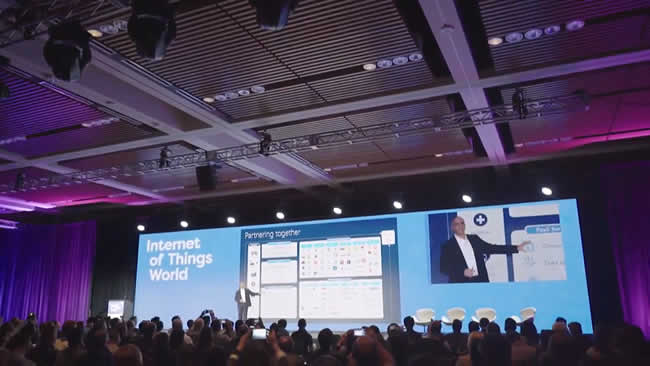
The report is based on a survey of over 100 IoT executives, in practice attendees (and decision makers) at one of the events of IoT or Internet of Things World as it’s also called. We asked some details about the respondents and added them at the bottom of this post.
Although the panel is quite diverse in terms of sectors (including ‘the’ industrial markets where we meet Industry 4.0 and Industrial IoT), geography, forms of projects (participants have deployed IoT in some form which can be relatively broad) and so forth, it offers a few good insights on a variety of topics.
These include the main concerns regarding IoT, how IoT security is dealt with, opinions regarding the combination of IoT and blockchain, and – how else could it be – IoT and 5G.
IoT executive concerns according to IoT World
According to the IoT World survey the top three concerns for IoT leaders are respectively 1) execution (implementation), 2) cybersecurity and 3) initial purchase cost with the two first clearly being the major ones.
Implementing the technology is mentioned as a key concern by 34% of respondents, security by precisely a quarter and initial purchase cost by 17%. The top 5 of concerns is completed with, respectively, scalability concerns (10% of respondents) and business buy-in challenges (8%). Upkeep costs rank sixth and only are a concern for 3% of surveyed IoT executives.
The fact that most decision makers are not concerned about ongoing upkeep costs, likely means they’re anticipating or already seeing ROI based on improved efficiencies per the IoT World report.
45% of companies say they are deploying IoT devices on a dedicated network to mitigate security risk
Since respondents have deployed IoT in some form the concerns might be influenced by the use case and the type of deployment in terms of scale (smaller internal project or larger, involving more stakeholders etc.) and the importance for the business. Other contributing factors would typically include the types of data leveraged and the reasons for which they are used and how (e.g. are personal data involved, are we talking about mission-critical data, are more actors and data streams involved etc.).
Some of these concerns are more important prior to leverage IoT in a meaningful way. The degree in which they are important will also depend on the case, scope etc. By way of an example: it’s known that in small-scale internal deployments that are still in somewhat of a pilot stage security is less looked at initially (which often leads to problems later).
Nevertheless, in more ‘serious’ IoT deployments you want the buy-in which doesn’t seem to be too much of a problem and of course you want the right skills, strategy and partners to execute and make it secure, which includes the ability to assess all these factors up-front.
The majority of those surveyed (66% to be precise) claims C-suite executives are supportive of their IoT implementations the IoT World survey found as the graphic above also shows.
Yet, as such this support doesn’t solve the major two concerns which go hand in hand. As the people behind IoT World put it: before any enterprise can implement new IoT technology, they must do their due diligence on potential security risks, their staff’s readiness to support the new technology and how to properly deploy it.
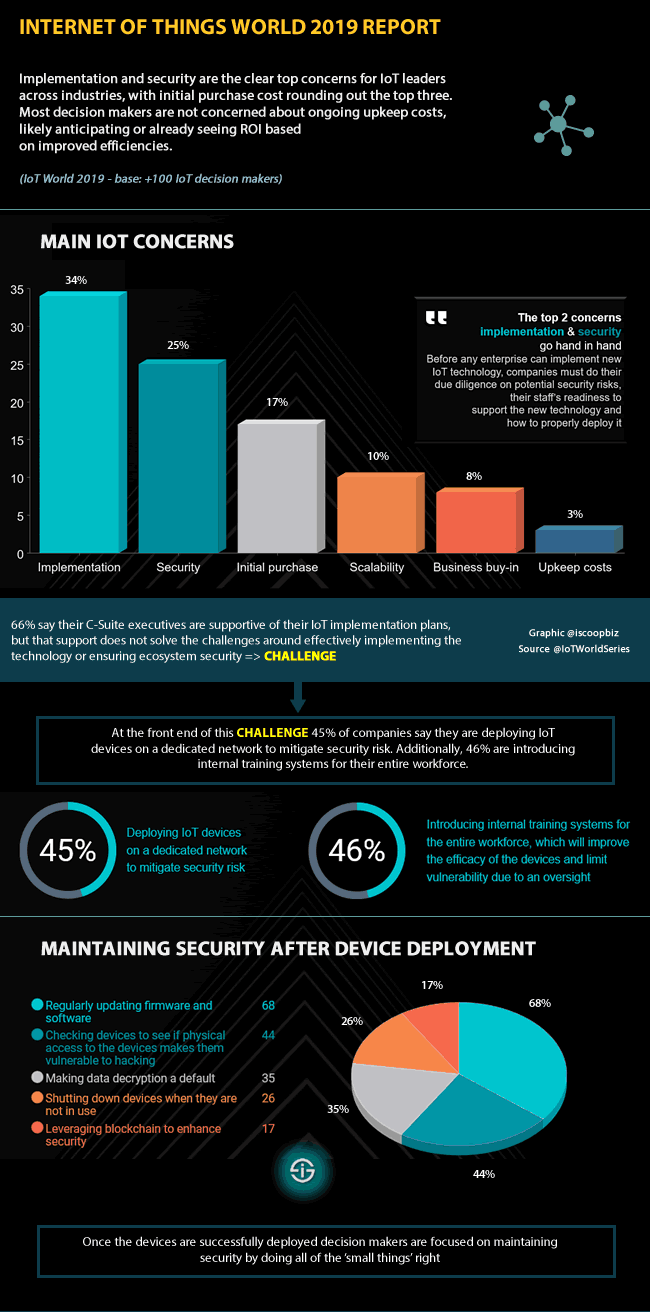
IoT World attendees on their IoT security measures
As you can see in the graphic above, in practice – at the front end of this challenge – the IoT World report says that 45% of companies say they are deploying IoT devices on a dedicated network to mitigate security risk.
IoT security, and in a context of Industrial IoT or Industry 4.0 – the somewhat different – industrial cybersecurity where industrial control systems and operational technology are involved too, also plays in a role of training.
IoT World found that 46% are introducing internal training systems for their entire workforce, which aims to improve the efficacy of the devices and limit vulnerability due to an oversight. Once the IoT devices are successfully deployed decision makers are focused on maintaining IoT security which includes ‘doing all of the small things’ right.
These ‘small IoT security’ things are:
- Regularly updating firmware and software, done by 68% of respondents.
- Checking devices to see if physical access to them makes them vulnerable to hacking which is (only) done by 44%.
- Making data decryption a default, good for 35% of respondents.
- Shutting down the (connected) devices when they aren’t being used (26%).
- Using blockchain to enhance security which seems to be done by 17% – according to the report.
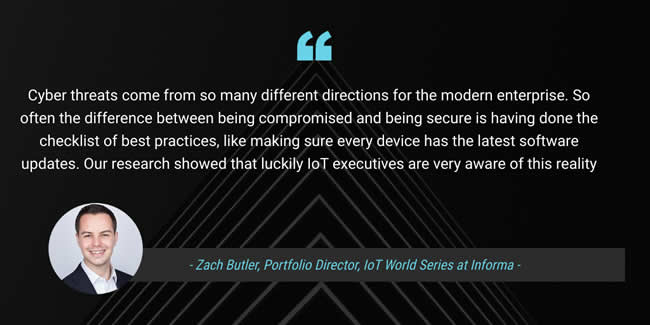
Zach Butler, Portfolio Director of IoT World Series at Informa, emphasizes the importance of IoT security, including all the little but crucial things and says that, as cybersecurity threats come a bit from all sides in our modern digital business environment, ‘so often the difference between being compromised and being secure is having done the checklist of best practices’, citing software updates as one example.
The Internet of Things World report findings on blockchain and the Internet of Things
The last ‘small thing’ in the mentioned list – leveraging blockchain for security – brings us to some data on what respondents think about IoT and blockchain – and what they do.
Perhaps it doesn’t come as a surprise that in this stage 29% of respondents don’t see a benefit in combining distributed ledger technology and IoT. It also, again, obviously depends on the respondents, their projects and so on.
When looking at those who see a benefit in the combination of IoT and blockchain there aren’t too many surprises either. In order of importance:
- 29% of respondents thinks that blockchain can help with IoT security given its background in cryptography. It’s indeed in security and trying to move to some form of trusted IoT many initiatives also can be found.
- 15% says that IoT architectures which rely on centralized servers to collect and store data will be able to write local ledgers that will sync with other localized ledgers to maintain a single, yet secure copy of the truth.
- 13% sees the benefits of smart contracts which enforce (predefined) business conditions on IoT interactions when applied to the data in the blockchain.
- Finally, 12% agrees that IoT transactions on the blockchain will be timestamped, ensuring that they are available when needed – again a matter of data and, in the end, trust.
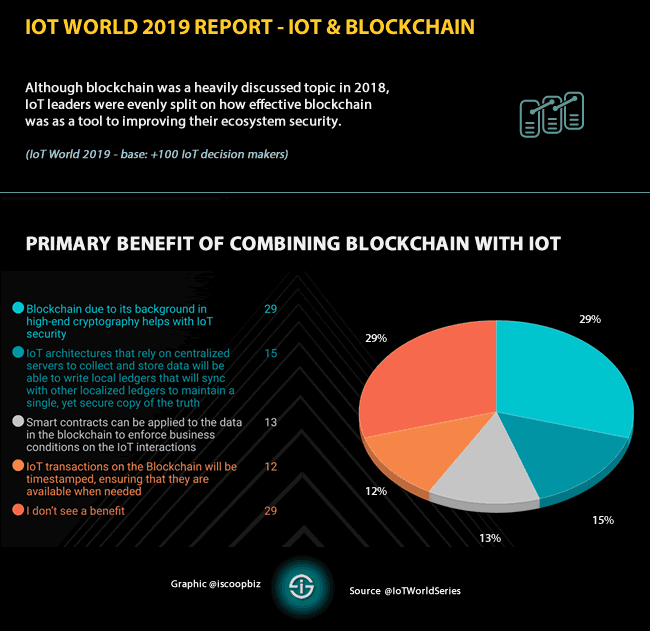
In case you’re in doubt of what blockchain, smart contracts and distributed ledger technology in general could mean and do (and in some cases do) for IoT, perhaps our article on the Internet of Trusted Things report from Kaleido Insights can shed more light. It, among others shows some uses cases for blockchain and IoT convergence with regards to IoT network management, supply chain (where it seems blockchain is stagnating a bit), end user security and smart contracts, to name a few. Identify, transactions, interactions and security are keywords in this regard although the Kaleido Insights report (from 2018) also looked at use cases on the IoT product level.
Additional IoT implementations ahead – the skills, training and recruiting picture
While people are an important element in most IoT concerns mentioned before, they of course also take center stage in making IoT implementations work and as users/customers/stakeholders in projects where IoT technologies are used.
As more IoT projects get deployed and additional IoT implementation is expected (also think about more mature or larger-scale IoT deployments once the waters have been tested and companies are ready to move to the next stage, sometimes discovering use cases as they go which often happens), training staff and hiring people is important.
64% plan on training current employees for new, more technical, roles
Or in the words of IoT World: with additional IoT implementation expected, IoT leaders are focusing on training and hiring to support this growing ecosystem.
Almost half (46%) of companies focus on internal training for their entire workforce. Yet they are also recruiting several specialists or preparing existing employees to become the types of specialists or take up the more technical roles as you would typically need them in the scope of broadening IoT deployments.
The data from the IoT World report:
- 64% plan on training current employees for new, more technical, roles
- 63% plan on hiring new employees which is split up as follows:
- 33% plans on hiring additional data analysts
- 30% plans on hiring people in a different technical role
- Finally, 10% plan to hire more remote employees.
5G, the enabler of massive-scale IoT deployments
The final findings, quotes, thoughts and data are all about 5G and IoT.
Obviously, also at the IoT World series events 5G plays an important role in 2019 (and no doubt for many years ahead), even if it’s still early days but those that invested now must continue to invest in their marketing efforts to sell which will be less easy for quite some operators in quite some countries (with quite some sales people needing to be retrained).
It’s all about the use cases and the expectations remain that 5G will initially be all about cars/vehicles and related smart city applications for obvious reasons. Yet, in the US it’s of course also a bit a different story than in some other regions.
Alexandra Rehak, since the early days of the IoT World series events (e.g. short post Internet of Things World Europe 2016), present at the events in her capacity as Internet of Things Practice Head at Informa’s Ovum, sums up the three areas where 5G will be a key enabler: on top of autonomous vehicles, that’s smart cities and Industrial IoT.
Rehak reminds that 5G will offer the necessary important capabilities for IoT – or, at the least, those IoT use cases – where high bandwidth, very low latency and ultra-reliability are essential. It’s mainly the very low to no latency that matters as in the use cases most prone for 5G each millisecond literally counts – as you can imagine with autonomous vehicles (not there yet) and highly critical applications where speed is, well, highly critical.
Once coverage and devices for 5G become more widely available, Rehak adds, 5G will also be the key enabler for massive-scale IoT deployments, not to be confused with the massive IoT from the Ericsson jargon where massive essentially means LPWAN (in this case the cellular ones, NB-IoT and LTE-M but in a non-Ericsson scope do add the others such as LoRaWAN, Sigfox etc. who are also present at IoT World 2019 USA – as are many partners from their ecosystem of course).
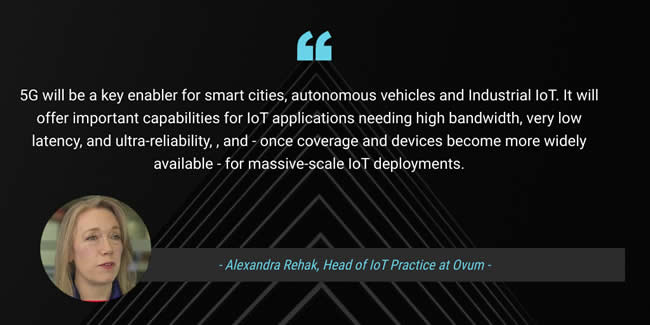
Rehak of course also knows that 5G will co-exist with several other wireless IoT connectivity solutions (and non-wireless ones) and stresses the many technology options to choose from with the diversity of IoT requirements meaning that no solution will dominate. Indeed, again the use case and project.
What do the IoT leaders surveyed for the IoT World report think about 5G and IoT?
- 41% say they would deploy IoT devices on a 5G network in 2019 if they could.
- 37% would rather have a wait and see approach on 5G and instead stick with their current wireless network.
- Finally, 22% do not rely on wireless networks at all for their IoT deployment.
More on IoT World and the IoT World report methodology
For additional information on the issues the IoT industry is facing, visitors at IoT World will of course see far more at the event and after it’s over the YouTube channel of IoT World series no doubt will offer some good overviews again, as will KNect356’s IoT World Today website/community/blog.
On top of the topics mentioned, IoT World 2019 among others focuses on areas such as smart home, edge computing, smart buildings and construction, AI, healthcare IoT, energy and utilities, and transportation.
As promised earlier we end with some data on the decision makers surveyed for the report. According to the IoT World spokesperson these come from a mixture of companies across verticals (retail, logistics, oil & gas, construction, telecoms, agriculture, financial services, healthcare, manufacturing, transportation & government), ‘who have deployed IoT in some form’ as mentioned before.
The people of IoT World 2019 were also kind enough to clarify that the ‘over 100 leaders surveyed’ are from all over the world including the USA, Finland, the UK, Colombia, Spain, China, Australia, Norway, Thailand, Slovakia, India, Uganda, Vietnam, Korea and more.
The IoT World survey was conducted internally and, if all is well, more data on the profiles of the respondents should be available. Yet, when making sense out of all the findings mentioned, keep in mind the diversity of the panel that emphasizes the global character of the IoT World event.
In case you’re not familiar with IoT World a quick overview: IoT World or Internet of Things World is a well-known IoT event series by KNect365 (a business of Informa that also owns Ovum, now OMDIA) with a European, Asian, African and US edition.
The latter is the major one and a leading global IoT business event (claiming 12,500+ attendees). With its other IoT-related events such as Smart Home Summit, Industrial IoT World and Smart Cities Summit, to name a few, KNect365 reaches over 25,000 visitors (there are several other events by IoT World Europe and so on). In Europe the annual IoT Solutions World Congress in Barcelona (global positioning) is more perceived as a leader (claiming 16,250 visitors) and for Industry 4.0 there is of course the giant Hannover Messe fair (over 215,000 visitors in 2019 with obviously more topics).

